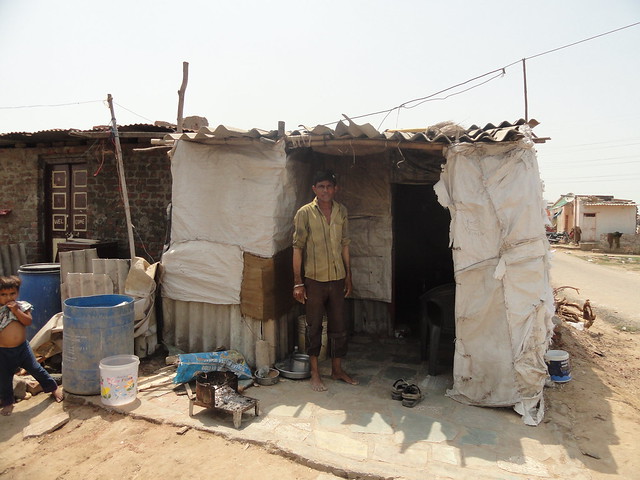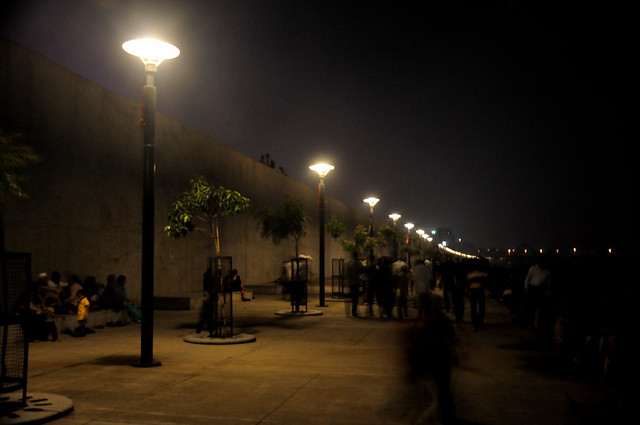By Vanya Mehta, TwoCircles.net,
The Sabarmati riverfront, for Ahmedabad residents, is a welcomed respite of clean walkways and greenery. Young middle class teenagers safely venture out with their friends in the evening to enjoy the pleasant views of the river, watching the riverfront light up. The elderly take their morning walks nearby adolescent trees, before the heat settles in for the day. Gujarati tourism, boasted by Chief Minister and BJP prime ministerial candidate Narendra Modi, is given a further facelift by the presence of this cultural landmark that stretches 11 kilometers across the length of the Sabarmati River.
Before filing his nomination papers to contest the Lok Sabha election from the spiritual capital of Hinduism, Varanasi, on April 21, Modi cited the success of the Sabarmati Riverfront Development Project as one of his many accomplishments. Mr. Modi wrote in a blog post on his website: “And when I talk about my commitment to clean the Ganga, it is not a mere promise. When I took over as CM in 2001 the condition of Sabarmati was similar. It was better known for hosting circuses and children playing cricket. Switch to 2014 and things are very different! We have brought water from the Narmada and now water flows through the Sabarmati. A world class Sabarmati River Front was created, which has emerged as a popular recreation and cultural spot in Ahmedabad. With the blessings of Baba Bholenath, this is what we intend to replicate in Varanasi.”

Ganesh Nagar
Take an unlucky turn down the wrong lane away from the city beautification effort on the banks of the river, however, and you will encounter a no man’s land bordering the Ahmedabad Sewage Dump facilities: the outpouring of the Sabarmati Riverfront Development Project’s rehabilitation scheme. In the Piplaj rehabilitation site, called Ganeshnagar, which borders the Sabarmati riverbank, for three years over 1,500 households have lived in self-made huts scattered throughout the dirt area in a state that is harsh to the naked eye squinting in the 45-degree wall of heat.
The government began evicting residents living in slums near the waterfront on November 9, 2011. The estimate of slum dwellers near the banks, according to the Sabarmati River Front Development Corporation Limited, was marked at 120,000 hutments on both sides. According to an estimate given to the Economic Times by managing director of the SRFDCL Guruprasad Mohapatra, 10,000 houses were given within the city limits to families affected by the Sabarmati construction project. The 1,500 families not put on the eviction list who were placed in temporary housing were given the shortest end of the stick: a few branches and a plot of dirt to build upon.
“We watched our house get bulldozed, television set and all,” Natwasingh Thakor, a resident who was shifted to Ganeshnagar in November 2011, said. His wife jumped in: “they said “niklo! Niklo!” and then before we knew it everything was broken.”
Fifteen days before the bulldozers arrived, these residents signed a contract with the municipal corporation workers stating they would be given a new home. “After they bulldozed our homes, a corporator came to ask us to move our things otherwise they would throw them out,” Mr. Kalpesh Govind Arvadya said. “We moved our belongings here and we haven’t received any homes and nobody has come to check on us.”
The project, which cost around Rs. 1,200 crore, included an urban development scheme to place slum dwellers in new flats. However, the couple thousand who did not get new flats in their name were told to reside on the grounds of Ganesh Nagar, given temporary plots to build a wooden shack with tarp but promised that new homes would be built. Though the smell of the nearby dumping site is one testament to the poor living conditions, there is also a High Tension Line running above the settlement that has the potential to induce electric fires, according to the NGO Saath.
“Three rains have already come and torn off our roofs,” an older woman resident of Ganeshnagar, Sitabehen, said. “We have to rebuild our homes every time the rain comes.”
Public sources funded the Sabarmati Riverfront Development Project, led by the Ahmedabad Municipal Corporation. Although the initiation dates to 1997, other estimates such as that given by the Center for Development say construction fully began in 2003, during the Modi administration.
Dr. Bimal Patel, the president and director of the Center for Environmental Planning and Technology, helped design the layout and structure of the riverfront with the Environmental Planning Collaborative, a private firm devoted to urban development. “In the last phase [of the Sabarmati project], the High Court ordered a temporary relocation to a small portion,” Dr. Patel said. “As it happens, a lot of others descended upon the grounds with hope of getting a new home.”
The response from the HC came as part of a longstanding battle between the court and the builders on how to go about with the riverfront development. An advocacy organization Sabarmati Nagarik Adhikar Manch filed Public Interest Litigation in the High Court in early 2011 requesting a delay to the project due to the lack of a proper plan for rehabilitation. The HC in a hearing on May 6 ordered to prevent the demolitions from beginning. According to the Indian Express, demolitions had already reached 1,000 hutments despite the HC order. At that point, at least 8,000 families were left homeless but many absolved into the nearby slums in Khanpur, to be largely forgotten about by the AMC.
When it comes to the religious and caste makeup of the area, the CFD states that the residents are split between Dalits and Muslims. “Polarization politics plays a role,” Mr. Pradeep Chako of the Center for Development said, when asked about the potential for communal tension. “They’re not supposed to be united.”
In this election, the slum dwellers do not feel any particular allegiance to the BJP. In another slum near Khanpur, where a group of people chose to live because the riverfront rehabilitation offered a home 30 kilometers from their work, refuse to choose a party.
“We supported Congress before, but now that this has happened, we don’t give a vote at all,” Ms. Sekh Begambano said. They believe neither Congress nor BJP have given any attention to the issue in the past year, or even visited the slum area of their constituency. “We’ve all spoken with each other and we are going to press the NOTA button.” A throng of 20 men and women nodded their heads in agreement.
On the matter of supplanting the Sabarmati River Front Development model onto the Ganga River, Dr. B.D. Tripathi of Benares Hindu University, who is also on the board for the National Ganga River Basin Authority, said “this is just a case of beautification.” Though he was clear to indicate his strong support of Mr. Modi, Dr. Tripathi added that what is required in Benares of a more environmental than surface attraction need. “As a scientist I am of the opinion that riverfront development is not a conservation program.”

Sabarmati riverfront at night [Photo by Amit Rawat]
Rather than focusing on riverfront development, Dr. Tripathi says he has suggested to Modi focusing the creation of a separate flow for industrial waste. A new sewage system was greatly improved in the Sabarmati River, intercepting sewage to divert it to treatment plants.
According to lawyer Amrish Patel, the families who were not given a rehabilitation scheme did not qualify because they lacked certain proof or documents that they were living in that slum area before 2001. The cutoff year changed in the BJP government and proof of residence would be difficult to come across given some of them were displaced more than once.
The bureaucratic nightmare for which India is typically known is a longstanding problem that is not unique to Gujarat. Nevertheless, the Modi government’s continuous self-accolades of development are not without its casualties.

